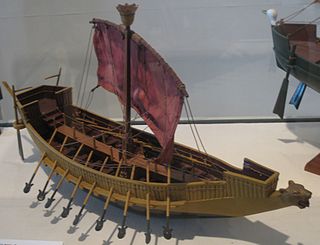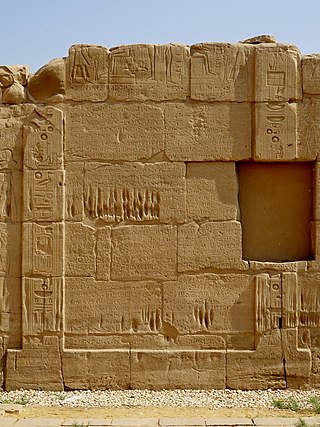Espionage, spying, or intelligence gathering is the act of obtaining secret or confidential information (intelligence). A person who commits espionage is called an espionage agent or spy. Any individual or spy ring, in the service of a government, company, criminal organization, or independent operation, can commit espionage. The practice is clandestine, as it is by definition unwelcome. In some circumstances, it may be a legal tool of law enforcement and in others, it may be illegal and punishable by law.

The Hittites were an Anatolian Indo-European people who formed one of the first major civilizations of Bronze Age West Asia. Possibly originating from beyond the Black Sea, they settled in modern day Turkey in the early 2nd millennium BC. The Hittites formed a series of polities in north-central Anatolia, including the kingdom of Kussara, the Kanesh or Nesha kingdom, and an empire centered on Hattusa. Known in modern times as the Hittite Empire, it reached its peak during the mid-14th century BC under Šuppiluliuma I, when it encompassed most of Anatolia and parts of the northern Levant and Upper Mesopotamia, bordering the rival empires of the Hurri-Mitanni and Assyrians.

Industrial espionage, also known as economic espionage, corporate spying, or corporate espionage, is a form of espionage conducted for commercial purposes instead of purely national security.

Surveillance is the monitoring of behavior, many activities, or information for the purpose of information gathering, influencing, managing, or directing. This can include observation from a distance by means of electronic equipment, such as closed-circuit television (CCTV), or interception of electronically transmitted information like Internet traffic. It can also include simple technical methods, such as human intelligence gathering and postal interception.

In military operations, military reconnaissance or scouting is the exploration of an area by military forces to obtain information about enemy forces, the terrain, and civil activities in the area of operations. In military jargon, reconnaissance is abbreviated to recce and to recon, both derived from the root word reconnoitre / reconnoitering.

Menmaatre Seti I was the second pharaoh of the Nineteenth Dynasty of Egypt during the New Kingdom period, ruling c. 1294 or 1290 BC to 1279 BC. He was the son of Ramesses I and Sitre, and the father of Ramesses II.

The Sea Peoples were a group of tribes hypothesized to have attacked Egypt and other Eastern Mediterranean regions around 1200 BC during the Late Bronze Age. The hypothesis was first proposed by the 19th century Egyptologists Emmanuel de Rougé and Gaston Maspero, on the basis of primary sources such as the reliefs on the Mortuary Temple of Ramesses III at Medinet Habu. Subsequent research developed the hypothesis further, attempting to link these sources to other Late Bronze Age evidence of migration, piracy, and destruction. While initial versions of the hypothesis regarded the Sea Peoples as a primary cause of the Late Bronze Age collapse, more recent versions generally regard them as a symptom of events which were already in motion before their purported attacks.

Mass surveillance is the intricate surveillance of an entire or a substantial fraction of a population in order to monitor that group of citizens. The surveillance is often carried out by local and federal governments or governmental organizations, but it may also be carried out by corporations. Depending on each nation's laws and judicial systems, the legality of and the permission required to engage in mass surveillance varies. It is the single most indicative distinguishing trait of totalitarian regimes. It is often distinguished from targeted surveillance.
Kadesh, or Qadesh, was an ancient city of the Levant on or near the headwaters or a ford of the Orontes River. It was of some importance during the Late Bronze Age and is mentioned in the Amarna letters. It was the site of the Battle of Kadesh between the Hittite and Egyptian empires in the 13th century BC.

The Battle of Kadesh took place in the 13th century BC between the Egyptian Empire led by pharaoh Ramesses II and the Hittite Empire led by king Muwatalli II. Their armies engaged each other at the Orontes River, just upstream of Lake Homs and near the archaeological site of Kadesh, along what is today the Lebanon–Syria border.
Intelligence assessment, or simply intel, is the development of behavior forecasts or recommended courses of action to the leadership of an organisation, based on wide ranges of available overt and covert information (intelligence). Assessments develop in response to leadership declaration requirements to inform decision-making. Assessment may be executed on behalf of a state, military or commercial organisation with ranges of information sources available to each.

The New Kingdom, also referred to as the Egyptian Empire, was the ancient Egyptian state between the 16th century BC and the 11th century BC. This period of ancient Egyptian history covers the Eighteenth, Nineteenth, and Twentieth Dynasties. Through radiocarbon dating, the establishment of the New Kingdom has been placed between 1570 BC and 1544 BC. The New Kingdom followed the Second Intermediate Period and was succeeded by the Third Intermediate Period. It was the most prosperous time for the Egyptian people and marked the peak of Egypt's power.

The Battle of Megiddo was fought between Egyptian forces under the command of Pharaoh Thutmose III and a large rebellious coalition of Canaanite vassal states led by the king of Kadesh. It is the first battle to have been recorded in what is accepted as relatively reliable detail. Megiddo is also the first recorded use of the composite bow and the first body count. All details of the battle come from Egyptian sources—primarily the hieroglyphic writings on the Hall of Annals in the Temple of Amun-Re at Karnak, Thebes, by the military scribe Tjaneni.

Ages in Chaos is a book by the author Immanuel Velikovsky, first published by Doubleday in 1952, which put forward a major revision of the history of the Ancient Near East, claiming that the histories of Ancient Egypt and the Israelites are five centuries out of step. He followed this with a number of other works where he attempted to complete his reconstruction of ancient history, collectively known as the Ages in Chaos series.

Tradecraft, within the intelligence community, refers to the techniques, methods, and technologies used in modern espionage (spying) and generally as part of the activity of intelligence assessment. This includes general topics or techniques, or the specific techniques of a nation or organization.

Ramesses II, commonly known as Ramesses the Great, was an Egyptian pharaoh. He was the third ruler of the Nineteenth Dynasty. Along with Thutmose III of the Eighteenth Dynasty, he is often regarded as the greatest, most celebrated, and most powerful pharaoh of the New Kingdom, which itself was the most powerful period of ancient Egypt. He is also widely considered one of ancient Egypt's most successful warrior pharaohs, conducting no fewer than 15 military campaigns, all resulting in victories, excluding the Battle of Kadesh, generally considered a stalemate.

The ancient Egyptian navy has a very extensive history almost as old as the nation itself. The best sources over the type of ships they used and their purposes come from the reliefs from the various religious temples that spread throughout the land. While the early ships that were used to sail the Nile were often made out of reeds, the ocean and seagoing ships were then made out of cedar wood, most probably from the woods of Byblos in present day Lebanon. While the use of navy was not as important to the Egyptians as it may have been to the Greeks or Romans, it still proved its worth during the Thutmoside campaigns and even in defending Egypt under Rameses III. Thutmose III understood the importance in maintaining a fast and efficient communications and supply line that would connect his bases in the Levantine region with Egypt. For this reason, he constructed his famous dockyard for the royal fleet near Memphis, whose sole purpose was to constantly supply the campaigning Egyptian army with additional troops as well as communication with Egypt and general supplies.

The Nineteenth Dynasty of Egypt, also known as the Ramessid dynasty, is classified as the second Dynasty of the Ancient Egyptian New Kingdom period, lasting from 1292 BC to 1189 BC. The 19th Dynasty and the 20th Dynasty furthermore together constitute an era known as the Ramesside period. This Dynasty was founded by Vizier Ramesses I, whom Pharaoh Horemheb chose as his successor to the throne.

The Egyptian–Hittite peace treaty, also known as the Eternal Treaty or the Silver Treaty, is the only Ancient Near Eastern treaty for which the versions of both sides have survived. It is also the earliest known surviving peace treaty. It is sometimes called the Treaty of Kadesh, after the well-documented Battle of Kadesh that had been fought some sixteen years earlier, although Kadesh is not mentioned in the text. The treaty was concluded between Egyptian pharaoh Ramesses II and king of the Hittite empire Ḫattušili III in c. 1259 BC. Both sides of the treaty have been the subject of intensive scholarly study. The treaty itself did not bring about a peace; in fact, "an atmosphere of enmity between Hatti and Egypt lasted many years" until the eventual treaty of alliance was signed.

The end of the 19th Dynasty of Ancient Egypt is a period of short-reigning rulers c. 1203-1187 BC. After the death of Merneptah, there was a conflict for the throne between Seti II and Amenmesse, which eventually resulted in the victory of Seti II. Seti II's reign was short, as he died within a year of regaining power. His widow, Tausret, took control with the support of Bay and the puppet Pharaoh Siptah. However, Tausret later eliminated Bay, and Siptah died under mysterious circumstances. This soon triggered a new power struggle between Tausret and Setnakhte. The struggle culminated in the triumph of Setnakhte, who is now remembered as the founder of the 20th Dynasty.















